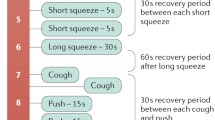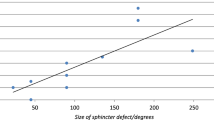Abstract
Children with anorectal malformation (ARM) often continue to have disturbances in bowel function long after reconstructive surgery. Anorectal manometry may be utilized to evaluate bowel function in these children. We aimed to describe the reported protocols and manometric findings in children with ARM post-reconstructive surgery and to investigate the correlation between manometric evaluation and bowel functional outcome. PubMed, EMBASE, and Google Scholar databases were searched from 1980 to 2021. Data were reviewed and extracted independently by two authors, in accordance with Preferred Reporting Items for Systematic Reviews and Meta-Analyses. Included studies were English articles reporting postoperative assessment of children (≤ 18 years) with ARM using anorectal manometry. From 128 articles obtained in the initial search, five retrospective cohort studies and one prospective study fulfilled inclusion criteria. The rectoanal inhibitory reflex and mean anal resting pressure were parameters most often reported to correlate with postoperative bowel function. The least reported parameters among the studies were high-pressure zone, rectal volume, and rectal sensation. Anorectal manometry could be an objective method providing important information for personalized management of postoperative ARM patients with bowel function issues, but lack of standardized protocols limits a comprehensive analysis of their utility.

Similar content being viewed by others
References
Nah SA, Ong CCP, Saffari SE, Ong LY, Yap TL, Low Y, Jacobsen AS (2018) Anorectal malformation & Hirschsprung’s disease: a cross-sectional comparison of quality of life and bowel function to healthy controls. J Pediatr Surg 53:1550–1554. https://doi.org/10.1016/j.jpedsurg.2017.08.018
Wigander H, Nisell M, Frenckner B, Wester T, Brodin U, Öjmyr-Joelsson M (2019) Quality of life and functional outcome in Swedish children with low anorectal malformations: a follow-up study. Pediatr Surg Int 35:583–590. https://doi.org/10.1007/s00383-018-04431-8
Wang Z, Hu L, Jin X, Li X, Xu L (2016) Evaluation of postoperative anal functions using endoanal ultrasonography and anorectal manometry in children with congenital anorectal malformations. J Pediatr Surg 51:416–420. https://doi.org/10.1016/j.jpedsurg.2015.09.024
Kyrklund K, Pakarinen MP, Rintala RJ (2017) Manometric findings in relation to functional outcomes in different types of anorectal malformations. J Pediatr Surg 52:563–568. https://doi.org/10.1016/j.jpedsurg.2016.08.025
Keshtgar AS, Athanasakos E, Clayden GS, Ward HC (2008) Evaluation of outcome of anorectal anomaly in childhood: the role of anorectal manometry and endosonography. Pediatr Surg Int 24:885–892. https://doi.org/10.1007/s00383-008-2181-1
Patcharatrakul T, Rao SSC (2018) Update on the pathophysiology and management of anorectal disorders. Gut Liver 12:375–384. https://doi.org/10.5009/gnl17172
Thorson AG (2002) Anorectal physiology. Surg Clin N Am 82:1115–1123. https://doi.org/10.1016/s0039-6109(02)00080-4
Dinning PG, Carrington EV, Scott SM (2015) The use of colonic and anorectal high-resolution manometry and its place in clinical work and in research. Neurogastroenterol Motil 27:1693–1708. https://doi.org/10.1111/nmo.12632
Rao SS, Azpiroz F, Diamant N, Enck P, Tougas G, Wald A (2002) Minimum standards of anorectal manometry. Neurogastroenterol Motil 14:553–559. https://doi.org/10.1046/j.1365-2982.2002.00352.x
Torresan F, Mandolesi D, Bonventre S, Usai-Satta P (2020) Differences between conventional anorectal manometry and high resolution/high definition anorectal manometry. In: Bellini M (ed) High resolution and high definition anorectal manometry. Springer, Cham, pp 49–68
Page MJ, McKenzie JE, Bossuyt PM, Boutron I, Hoffmann TC, Mulrow CD, Shamseer L, Tetzlaff JM, Akl EA, Brennan SE, Chou R, Glanville J, Grimshaw JM, Hróbjartsson A, Lalu MM, Li T, Loder EW, Mayo-Wilson E, McDonald S, McGuinness LA, Stewart LA, Thomas J, Tricco AC, Welch VA, Whiting P, Moher D (2021) The PRISMA 2020 statement: an updated guideline for reporting systematic reviews. Int J Surg 88:105906. https://doi.org/10.1016/j.ijsu.2021.105906
Stang A (2010) Critical evaluation of the Newcastle-Ottawa scale for the assessment of the quality of nonrandomized studies in meta-analyses. Eur J Epidemiol 25:603–605. https://doi.org/10.1007/s10654-010-9491-z
Kumar S, Al Ramadan S, Gupta V, Helmy S, Debnath P, Alkholy A (2010) Use of anorectal manometry for evaluation of postoperative results of patients with anorectal malformation: a study from Kuwait. J Pediatr Surg 45:1843–1848. https://doi.org/10.1016/j.jpedsurg.2010.04.012
Martins JL, Pinus J (1996) Clinical and manometric postoperative evaluation of posterior sagital anorectoplasty (PSARP) in patients with upper and intermediate anorectal malformations. Sao Paulo Med J 114:1303–1308. https://doi.org/10.1590/s1516-31801996000600004
Nagasaki A, Ikeda K, Hayashida Y, Sumitomo K, Sameshima S (1984) Assessment of bowel control with anorectal manometry after surgery for anorectal malformation. Jpn J Surg 14:229–234. https://doi.org/10.1007/BF02469573
Senel E, Demirbag S, Tiryaki T, Erdogan D, Cetinkursun S, Cakmak O (2007) Postoperative anorectal manometric evaluation of patients with anorectal malformation. Pediatr Int 49:210–214. https://doi.org/10.1111/j.1442-200X.2007.02342.x
Mert M, Sayan A, Köylüoğlu G (2021) Comparing the fecal continence scores of patients with anorectal malformation with anorectal manometric findings. Pediatr Surg Int 37:1013–1019. https://doi.org/10.1007/s00383-021-04884-4
Hedlund H, Peña A, Rodriguez G, Maza J (1992) Long-term anorectal function in imperforate anus treated by a posterior sagittal anorectoplasty: manometric investigation. J Pediatr Surg 27:906–909. https://doi.org/10.1016/0022-3468(92)90395-n
Trajanovska M, King SK, Gibb S, Goldfeld S (2018) Children who soil: a review of the assessment and management of faecal incontinence. J Paediatr Child Health 54:1136–1141. https://doi.org/10.1111/jpc.14173
Kim JH (2010) How to interpret conventional anorectal manometry. J Neurogastroenterol Motil 16:437–439. https://doi.org/10.5056/jnm.2010.16.4.437
Vriesman MH, Koppen IJN, Camilleri M, Di Lorenzo C, Benninga MA (2020) Management of functional constipation in children and adults. Nat Rev Gastroenterol Hepatol 17:21–39. https://doi.org/10.1038/s41575-019-0222-y
Strisciuglio C, Banasiuk M, Salvatore S, Borrelli O, Staiano A, Van Wijk M, Vandenplas Y, Benninga MA, Thapar N (2022) Anorectal manometry in children. the update on the indications and the protocol of the procedure. J Pediatr Gastroenterol Nutr 74:440–445. https://doi.org/10.1097/MPG.0000000000003379
Author information
Authors and Affiliations
Contributions
SR and SAN had full access to all of the data in the study and take responsibility for the integrity of the data and accuracy of the data analysis. Study concept and design: SR and SAN; acquisition of the data: SR, TWS, and DEE; Analysis and interpretation of the data: SR, TWS, DEE, AS, and SAN; drafting of the manuscript: SR, DEE, TWS, and SAN; critical revision of the manuscript for important intellectual content: AS, SS, and SAN.
Corresponding author
Ethics declarations
Competing interests
The authors declare no competing interests.
Conflict of interest
The authors did not receive support from any organization for the submitted work. The authors have no relevant financial or non-financial interests to disclose.
Additional information
Publisher's Note
Springer Nature remains neutral with regard to jurisdictional claims in published maps and institutional affiliations.
Supplementary Information
Below is the link to the electronic supplementary material.
Rights and permissions
About this article
Cite this article
Rajasegaran, S., Tan, W.S., Ezrien, D.E. et al. Utility of postoperative anorectal manometry in children with anorectal malformation: a systematic review. Pediatr Surg Int 38, 1089–1097 (2022). https://doi.org/10.1007/s00383-022-05152-9
Accepted:
Published:
Issue Date:
DOI: https://doi.org/10.1007/s00383-022-05152-9




